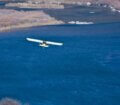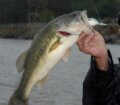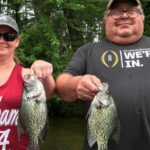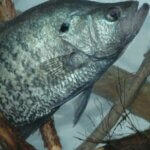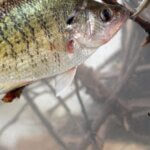Editor’s Note: With the strategies you’ll learn this week, you can develop a game plan on how to fish a new lake. With this information, a large number of potential crappie hotspots will come to mind. However, depending on the time of year you plan to fish, you also must consider where the crappie will be along their seasonal migration routes.
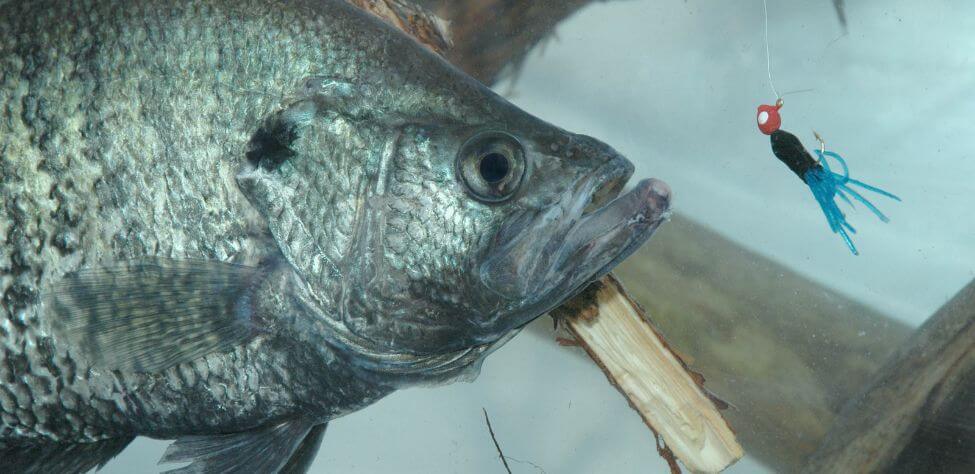
Grain Elevators’ Pilings: One day before a crappie tournament, two men set sail on a practice run in a rickety old wooden boat that would have made a better flower box for someone’s yard than a fishing boat. The anglers didn’t go more than 100 yards from the launch site, before they returned to the dock wet over their ankles. The boat had sprung several leaks and threatened more than once to capsize. The men turned the boat upside down, went to the hardware store, bought some fiberglass and repaired the boat’s leaky hull. The next day at the tournament, the two anglers waited 30 minutes after take-off before leaving because, as one told me, “We thought those big boats blasting out of the creek would create so many waves that our little boat would sink.”
When they finally started away from the dock on the morning of the tournament, you could hear their ailing motor gasping for air. I wondered if another angler would have to pull them back in to the pier before noon. The men travelled only a few hundred yards out of the mouth of the creek and pulled up on the other side of the river behind a grain elevator loading barges with wheat and corn. Shortly before the tournament ended, the two anglers and their leaky-bottomed johnboat arrived back at the dock before anyone else. As they tied-up their ailing boat, I assumed they hadn’t caught any crappie and had given up early in an attempt to return to the pier before the big, high-performance bass boats flew into the creek to beat the clock at the end of the day. But when the judges weighed the fish from all the contestants, these two men had taken the heaviest limit of crappie in the contest.
The champions explained their strategy at the post-tournament interview to an astonished crowd. “We knew we couldn’t go far up the river because our motor wasn’t running well. We spotted the concrete pilings where the barges tied up to be loaded at the grain elevator. The pilings resembled bridge pilings by providing vertical structure along the edge of the main river channel. We also knew that very few, if any, anglers fished these concrete pilings, due to their location on the back side of the barges. At first glance, they didn’t appear to hold crappie. We assumed that most crappie fishermen wouldn’t choose to fish close to the launch site. When we left the take-off area last, we puttered over to the barge-loading region and fished live minnows beside the pilings. We caught crappie all day.”
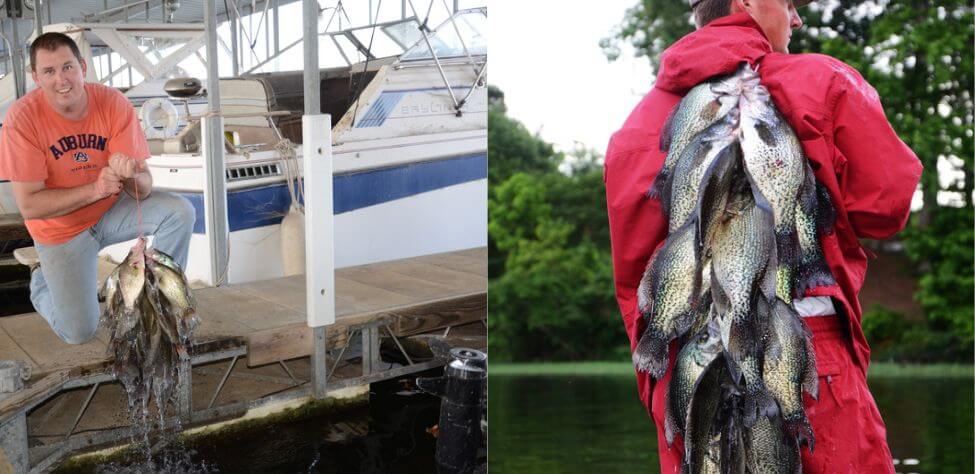
Marinas and Boat Ramps: Marinas too may produce slab-sized crappie, although most fishermen think they won’t. Years ago the late W.T. Womble of Tifton, Georgia, a crappie guide then at Jack Wingate’s Lunker Lodge in Bainbridge on Lake Seminole, specialized in catching a limit of crappie around the Lunker Lodge marina. “Because crappie fishermen put their boats in at marinas, and marinas have so much boat traffic, most anglers assume these spots don’t hold crappie. However, remember that marinas . . .
- “provide deep-water structure and other ideal habitat for crappie in their bays and coves,
- “offer shade and protection from the wind and the weather,
- “concentrate baitfish,
- “have lights on at night that attract even more baitfish and
- “receive little fishing pressure. I’ve also learned that often one of the best areas around a marina to catch crappie lies next to the boat ramp. By trolling a crappie jig in deep water to the left and the right of a boat ramp, I’ve caught tremendous numbers and sizes of crappie.
“Too, anglers generally don’t fish around a boat ramp. But often fishermen heavily stock the spot with crappie by releasing their small crappie by the ramp after returning from fishing on the lake. Many of these small crappie will remain in that section of the lake, feed on baitfish and grow to larger sizes.”
You Can Catch More Crappie on a New Lake: To catch the most crappie on any new lake you fish, do your homework. If you’ll spend a day or two learning the lake before you fish it, you’ll increase your odds for catching crappie. Most people who fish a new lake put their boats in at the launch and pray they can find structure that holds crappie. They have no game plans and no areas targeted to fish. Therefore, they usually won’t experience success.
However, study your map, do your aerial and boat reconnaissance, and search for unusual places to locate more potential crappie hotspots than you can fish in several weeks on any new lake. Anglers catching the most and biggest crappie on a new lake are accomplishing those tasks by embracing new technology.
I have as much fun finding crappie as catching them. With this game plan, I consistently can locate and take more crappie on a new lake.
Expert Guidebooks on Crappie Fishing: Best Sellers
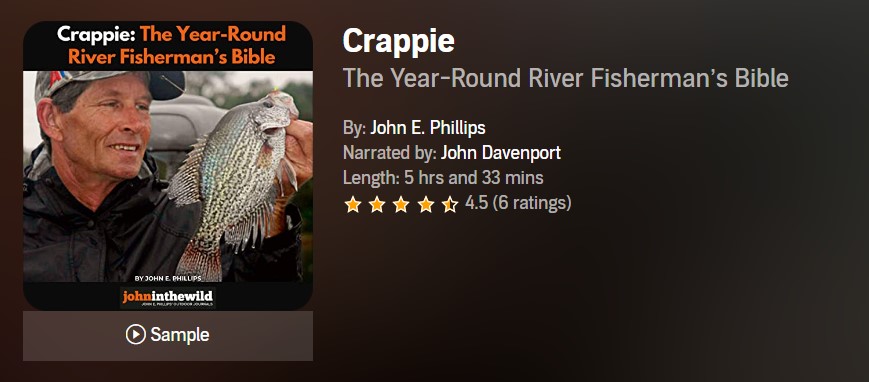
Fishing rivers for crappie and being able to find and catch speckled sides consistently has long been one of the mysteries in the crappie-fishing world.
“One of the reasons that river systems are so difficult to fish is because the water’s either rising or falling in them,” says Ott DeFoe, the 2019 Bassmaster Classic champion.
Rivers also are very susceptible to floods and droughts and constantly have current moving through them. Often fast current or slow current in rivers is created by rain or droughts upstream. When rivers flood, they can wash away fish habitat like logs, sunken trees, manmade brush piles and stake beds. But that’s the time when a river also creates new crappie hot spots that haven’t been available to the crappie or the fishermen before the flood.
Because river systems are so unpredictable, I’ve felt the best way to get the most useful information on how to fish rivers for crappie is to talk to numbers of anglers all over the nation to learn their best tactics.
In this book, I’ve gleaned crappie-fishing wisdom from three dozen crappie anglers and guides from a dozen states, who consistently catch crappie at all times of the year. The tournament crappie fishermen in this book fish most of the country at different times of the year on various river systems and lakes. And, these anglers use techniques you never may have considered, including:
- Setting up a casting ring with your electronics to keep you from getting too close to the crappie that are holding on underwater structure, while you’re fishing all the way around the structure;
- Buying an automotive laser temperature gauge to measure water temperature
- Evaluating the most-productive places to sink brush and other structure, according to prevailing wind direction, the crappie’s summer, fall, winter, and spring migration patterns, and other factors.
VERSIONS: AUDIBLE, KINDLE & PRINT
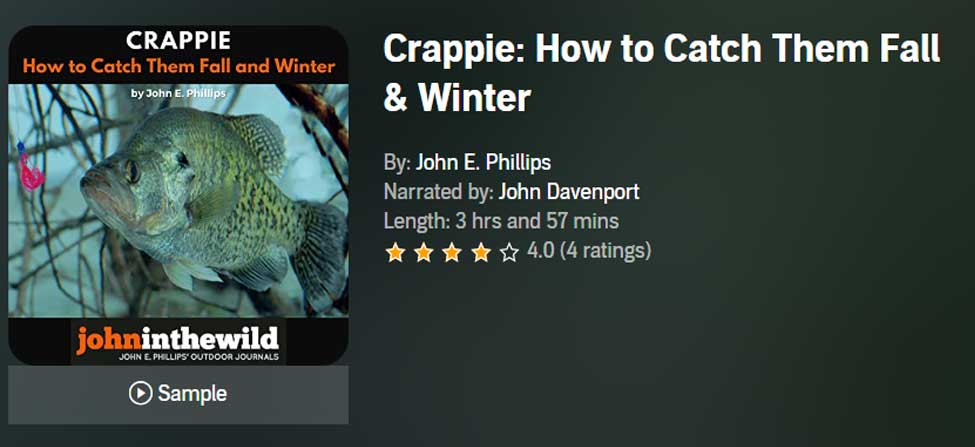
Crappie: How to Catch Them Fall & Winter
Yes, you can catch and eat crappie during the fall and winter months. Often, at many places, you’ll catch more and bigger crappies in the fall and winter than you do in the spring and summer. To learn where to find and how to catch cooler weather speckled sides, we’ve interviewed a wide variety of some of the nation’s best tournament crappie fishermen and guides.
Many of the individuals you’ll hear about in this audiobook are tournament crappie pros who travel the country to fish in crappie tournaments from New York to Florida and from Virginia to California. They use the latest crappie-finding equipment, the best poles, rods, reels, line, and the most-productive baits. Each of the people mentioned in this book has the ability to be dropped out of an airplane anywhere in the United States and catch crappie on any lake close to where they land that contains crappie.
From over 50 years of crappie-fishing experience, I’ve learned that you get the best advice by interviewing a large number of people who have different tactics and fish under various water, weather, and fishing-pressure conditions.
In this book, you will learn:
- How to spider-rig (slow-troll), which is one of the fastest-growing techniques for catching the most and biggest crappies in the shortest time
- How to catch crappie on crank baits and when and where using a crank bait is the most appropriate
- How to find areas of any lake that will hold large schools of crappies during the winter months – places you can return to time and again and expect them to be there
- Why competing in crappie tournaments is one of the quickest ways to learn how to catch more and bigger crappie faster
- Why and how to look for and catch the biggest crappie in a lake
VERSIONS: AUDIBLE, KINDLE & PRINT

Catch Crappie All Year: Fishing a Single Pole, Using No Boat, and Farming Crappie
I’ve interviewed some of the best crappie fishermen in the nation for my new audiobook, Catch Crappie All Year: Fishing a Single Pole, Using No Boat and Farming Crappie to learn how, where, and when to catch the most crappie with or without a boat while single-pole fishing. I’ve also included information on how to grow a crop of crappie to catch every day of the year. Although I’ve fished in fully rigged crappie boats costing $45,000 – $90,000-plus that can have up to 16 rods at one time to slow troll, I still enjoy….
- Watching a quill cork sink in a brush top
- Fishing with an ultralight spinning rod
- Reeling jigs or minnows along a grass line and feeling that thud when a crappie takes the bait
- Fishing with family and friends, even if we all can’t fit in one boat
- Participating in less-expensive and hassle-free yet highly-productive crappie fishing like single poling
I’ve tried to capture in this new audiobook the old way of crappie fishing with new twists and detailed tactics to aid you in catching crappie all year.
VERSIONS: AUDIBLE, KINDLE & PRINT
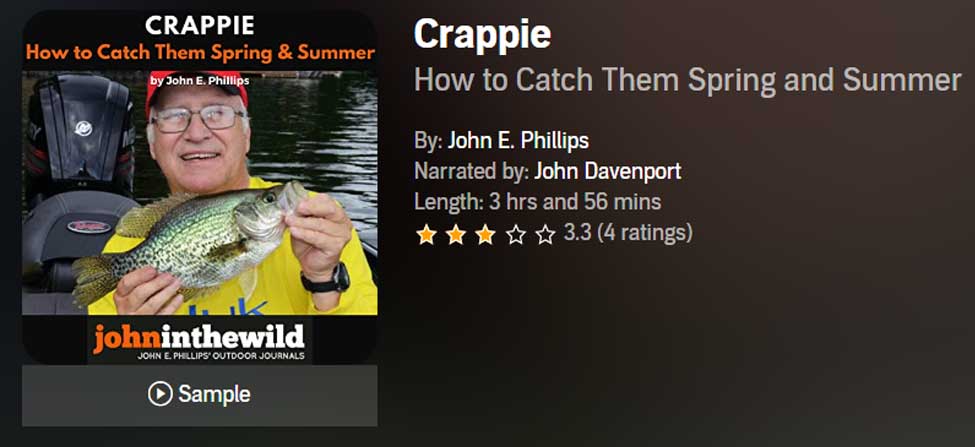
Crappie: How to Catch Them Spring and Summer
You can catch crappie all year long if you know where to find them and what techniques to use to catch them. However, crappie fishing is so technical these days, and we’ve learned so much about how to crappie fish because of the professional crappie-fishing circuits, that one book can’t hold all the information.
This book is the first of a three-part series on how, where, and when to catch crappie, with the best crappie fishermen in the nation. Many of these men have proven they are the best, because they’ve won crappie-fishing tournaments or been successful fishing guides for many years.
This audio version of Crappie: How to Catch Them Spring and Summer includes crappie pros like Ronnie Capps, who has won seven national championships and over $1 million with his partner Steve Coleman.
We also have Malcolm Lane, Stokes McClellan from North Carolina, Billy Blakeley from Reelfoot Lake, John Woods, Kent Driscoll, fishing biologist and professional basser Ken Cook, and many others. We asked the questions that crappie fishermen want answered about how to find and catch crappie during the spring and summer months, and these fishing tips are the result.
In the world of crappie fishing, no one man knows it all, and that’s why I’ve interviewed so many fishermen, asked so many questions, and tried to get so many answers for you about how to fish.
VERSIONS: AUDIBLE, KINDLE & PRINT

